Chapter 3:
Undergraduate Student Success
Goals
The University of California seeks to enable all freshmen and transfer entrants to complete their undergraduate degrees in a timely fashion and to ensure that their education prepares them to be the next generation of leaders for California, the nation and the world.
Improving graduation rates
UC campuses have instituted a wide range of programs to promote the long-term academic success of their undergraduates, especially low-income and underrepresented minority students. These include academic preparation programs and individual student counseling and mentorship opportunities that assist students in pursuing their studies, achieving academic success and graduating in a timely fashion. By traditional graduation rate measures, UC’s undergraduates are highly successful.
UC’s four-year graduation rates for freshmen have risen significantly over the past 15 years — from 46 percent for the 1997 entering cohort to 64 percent for the 2012 cohort. The most recent six-year graduation rate, for the 2010 entering cohort, is 85 percent, which increases to 87 percent when including students who transfer to non-UC institutions and still graduate within six years. In addition, time to degree has steadily improved, with freshman entrants now taking 4.1 years, on average, to graduate.
Transfer entrants have made similar gains, with average two-year graduation rates increasing from 37 percent for the 1997 entering cohort to 56 percent for the 2014 cohort. The most recent four-year graduation rate for transfers (2012 entering cohort) is 88 percent and the average time to degree is 2.3 years.
factors that affect graduation rates
Underrepresented minority (URM) students have lower graduation rates when compared to non-URM students. Many factors contribute to differences in graduation rates between racial and ethnic groups, including socioeconomic background and differences in academic preparedness.
For instance, an underrepresented minority student may be more likely to attend a poorly performing high school. Being both low-income and first-generation will often affect a student more than just having one of those characteristics, even though they are closely correlated.
In the 2016-17 California Budget, special funds under the state’s Local Control Funding Formula (LCFF+) were provided to UC to expand enrollment and support the academic success of students who attended high schools with high concentrations of foster youth, English learners and/or those eligible for a free or reduced-price meal.
Holding a job while attending school is often thought to negatively affect graduation rates. However, undergraduates have to work a significant number of hours (i.e., 21 hours or more) for employment to play a role. Only a very small proportion of undergraduates work that many hours while attending school.
Lack of basic needs may also have a negative effect on student academic success. As part of the Global Food Initiative, UC has examined food access issues, and results from the 2014 Student Food Access and Security Study show that 48 percent of undergraduate respondents report low or very low food security. Responding to this finding, in 2016 the UC committed 3.3 million dollars to tackle food access issues over a two year time period.
Undergraduate outcomes
The number of undergraduate degrees awarded by UC over the past 15 years has grown by 55 percent, from about 32,700 degrees in 1999–2000 to 50,800 degrees in 2015–16. Increases in the size of the entering freshman class and improving graduation rates have contributed to this growth. More than one-third of the undergraduate degrees awarded by UC in 2015–16 were in STEM disciplines (science, technology, engineering and mathematics).
Four years after graduation, more than one-quarter of bachelor’s degree recipients have enrolled in graduate or professional programs.
Analysis of wage data reported for UC alumni working in California may show differences in earnings depending on the student’s major. But the earning capacity of UC alumni across majors increases rapidly; ten years after graduation, alumni have doubled what they were earning at two years post-graduation. Success in the California labor workforce is seen across all socioeconomic groups, including students whose families qualified for federal Pell Grants. Within five years of graduation, the majority of Pell Grant recipients earn an average income higher than their parents’ combined incomes during the time those students attended UC (approximately $50,000).
California employment data for UC bachelor’s degree recipients also illustrate the benefits of a UC degree. They show that, by ten years after graduation, approximately 30 percent of life science majors work in health care and social assistance; more than 15 percent of engineering/computer science majors are in the internet and computer systems industry and another 13 percent are in engineering services; and 15 percent of all UC graduates are employed in K–12 and higher education combined.
Looking forward
Despite UC’s record of success, there are continued systemwide and campus efforts to improve undergraduate outcomes. Through the application of state funds, UC hopes to make additional progress in closing equity gaps in graduation rates between racial/ethnic groups.
For more information
Over sixty percent of UC freshman graduate within four years, a higher rate than comparable AAU public universities.
3.1.1 Freshman graduation rates for all students, UC and comparison institutions, Cohorts entering fall 2010, 2011 and 2012; fall 2009 cohort for AAU comparison

Source: UC Corporate Student System and IPEDS1
UC’s six-year graduation rate is higher than that of comparable AAU public institutions. UC’s four-year graduation rates for freshmen have risen significantly over the past 15 years, from 46 percent for the 1997 entering cohort to 64 percent for the 2012 cohort. This improvement is due to many factors, including campus programs supporting four-year completion, improvements in academic preparation of incoming students and the current costs of a UC education, all of which motivate students to complete their degrees more quickly.
UC’s freshman six-year graduation rate has held steady at 85 percent for the past two cohorts, the highest since 1995.
More information on trends in UC freshman graduation rates can be found here.
The six-year graduation rate of UC freshmen is close to 90 percent when students who finished their degree at a non-UC institution are included.
3.1.2 Freshman graduation rates, including those who graduated from a non-UC institution, Universitywide and UC campuses, Cohort entering fall 2010
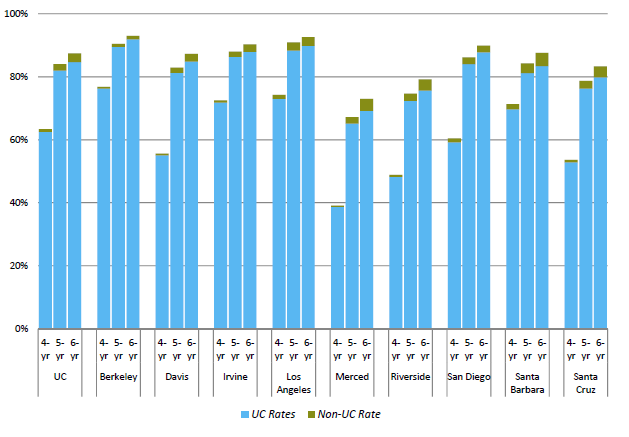
Source: UC Corporate Student System and the National Student Clearinghouse1
The extended graduation rate of students who begin their studies as freshmen at UC includes those who transferred to a non-UC institution and completed their bachelor’s degree within four, five or six years.
By this measure, UC’s overall six-year graduation rate is about 87 percent. The effect of the extended graduation rate varies by UC campus, with Berkeley having fewer students who earn a degree outside of the UC system, while the six-year rates at Merced, Riverside, Santa Barbara and Santa Cruz improve by as much as 4 percentage points when students who complete their degree at a non-UC school are counted.
Almost 60 percent of transfer students graduated within two years.
3.1.3 Transfer graduation rates, Cohorts entering fall 2012, 2013 and 2014

Source: UC Corporate Student System1
The two-year graduation rate for transfer students has been relatively consistent over the past three cohorts. The two-year graduation rate for transfers is currently at 56 percent, the highest since 1995. The four-year rate is 88 percent, compared to 85 percent for the six-year transfer graduation rate. More information on trends in UC transfer graduation rates can be found here.
Underrepresented minority (URM) students at UC graduate at higher rates when compared to URM students at other AAU public institutions.
3.1.4 Freshman graduation rates by race/ethnicity, Cohorts entering fall 2009, 2010, 2011 and 2012
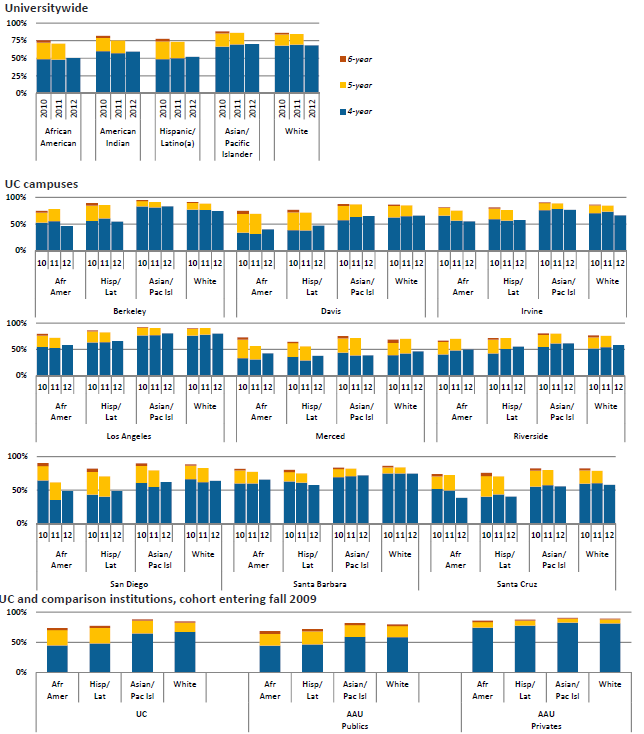
Source: UC Information Center Data Warehouse and IPEDS. Rates for American Indian students are not shown by campus due to small numbers of students.
Transfer students of all racial and ethnic groups graduate at high rates.
3.1.5 Transfer graduation rates by race/ethnicity, Cohorts entering fall 2003, 2007 and 2011
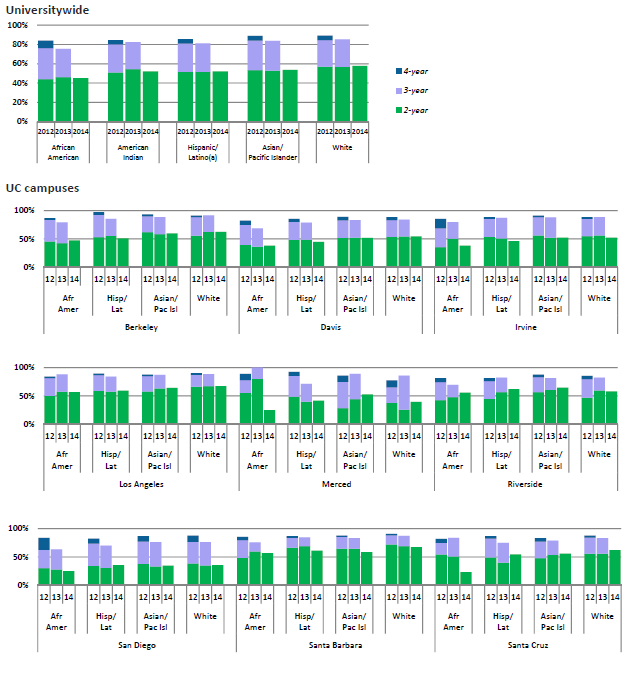
Over 80 percent of Pell students graduate within six years.
3.1.6 Freshman graduation rates by Pell Grant receipt status, Cohorts entering fall 2010, 2011 and 2012
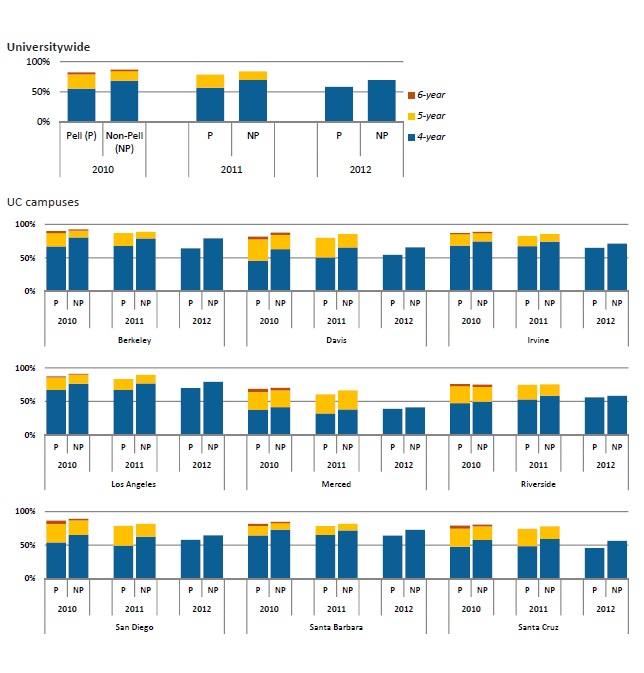
Pell Grant recipients graduate at rates comparable to non-Pell recipients, 82 percent and 87 percent respectively. Although there is a 13-percentage-point gap at the four-year mark between Pell recipients (56 percent) and non-Pell recipients (69 percent), this gap is reduced to 5 percentage points at the six-year mark.
Graduation rates among transfer students who received Pell Grants are comparable to other students, especially at the three‐ and four‐year marks.
3.1.7 Transfer graduation rates by Pell Grant receipt status, Cohorts entering fall 2012, 2013 and 2014
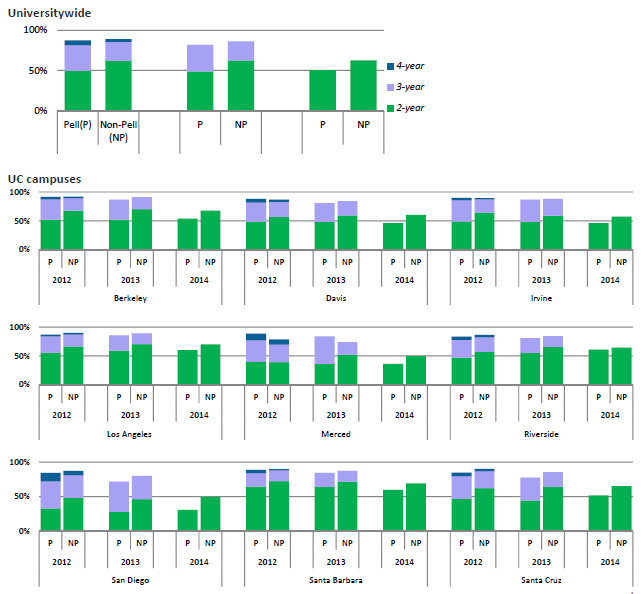
For the 2012 cohort, Pell and non-Pell Grant recipients graduated at comparable rates of 87 percent and 89 percent respectively. For the two-year completion rate, however, the thirteen percentage point gap decreases to two percentage points by year four.
See trend data in the 2016 Accountability Report.
As graduation rates rise, undergraduate students at UC are also graduating more quickly.
3.1.8 Average time to degree, Fall 2009 entering freshmen and transfer cohorts

The average time to earn a bachelor’s degree at UC has decreased fairly steadily since 1994. Students entering as freshmen take an average of 4.1 years, which is about 7 percent less time than in 1994.
For students entering as transfers, the average time to degree is 2.3 years, about 12 percent less time than in 1994.
Freshman retention rates are high, but there is room for improvement. Transfer retention rates are also high and very close to freshman retention rates.
3.2.1 First-year retention rates, Cohorts entering fall 2015

Source: Freshmen data from IPEDS1; transfer data from UC Corporate Student System. Comparison data on retention rates are not available for transfer students.
Improving first-year retention is key to raising graduation rates. The current universitywide retention rate is 93 percent. This is higher than non-UC AAU institutions (91 percent), but lower than AAU private institutions (96 percent).
Studies of retention data divide students into two groups: those who leave UC in good academic standing (i.e., GPA ≥ 2.0) or transfer to another UC campus, and those who leave UC in poor academic standing (i.e., < 2.0). The strategies needed to address retention vary based on this distinction.
For students leaving in good academic standing, some campuses are considering expanding honors programs or providing opportunities for undergraduate research as early as the freshman year.
For those leaving in poor academic standing, some UC campuses are using summer bridge or early orientation programs so that students have a productive jump-start on a smooth transition to campus life. Other campuses are looking into housing and residential programs and cohort programs to integrate undergraduates into college.
Campuses vary in terms of whether transfer students are more likely to leave in poor or good academic standing, and very few leave for another UC campus. Like entering freshmen, transfer students benefit from a smooth transition to campus in their first year. Several UC campuses have summer programs to support transfer students.
Universitywide both lower and upper division students take a similar amount of units.
3.2.2 Average number of attempted units per student per term, Academic years 1999–00 to 2015–16 for universitywide and 2015–16 for UC campuses [NOTE SCALES]
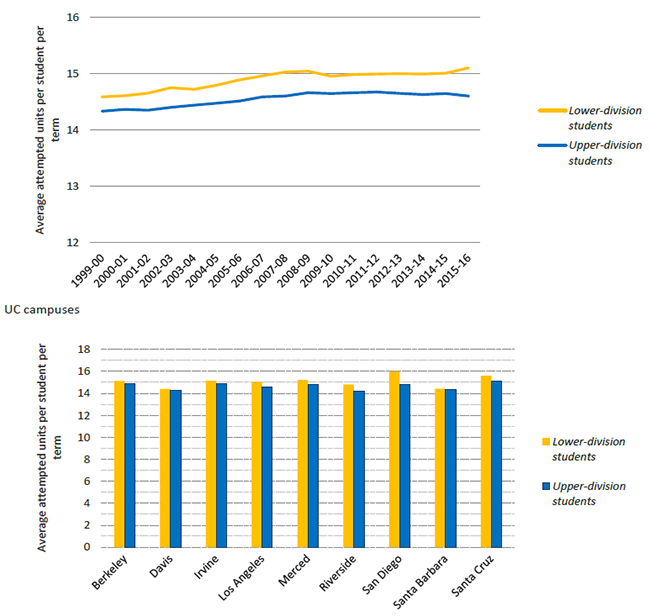
Source: UC Corporate Student System1
While there was a slight dip in the average number of units upper-division students attempted between 2014–15 and 2015–16, the overall trend is clear, both upper-division (14.5) and lower division students (14.8) are attempting more units over time.
Social science, life sciences, and arts and humanities are the largest segments of bachelor’s degree recipients.
3.3.1 Undergraduate degrees awarded by discipline, UC and comparison institutions, 2000–01 and 2014–15

Source: IPEDS
About 36 percent of all undergraduate degrees awarded by UC in 2014–15 were in science, technology, engineering and mathematics (STEM) fields. This is higher than the proportion at AAU public and private comparison institutions (32 and 33 percent, respectively). Indicator 10.3.1 shows UC’s share of the degrees awarded in the state of California.
More than half of students contributed to a class discussion, and more than a third found a course so interesting that they did more work than required. More than one third of students worked with a faculty member on an activity other than coursework at least once.
3.3.2 Student responses to questions about areas of engagement, Universitywide, Spring 2012 to 2016
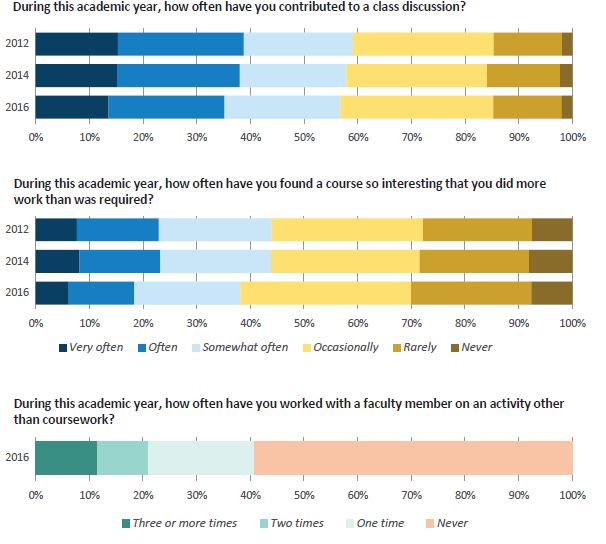
Source: UCUES
More than half of students reported that they contributed to class discussions at least somewhat often, and more than a third at least somewhat often went beyond required coursework in a class they found interesting. Forty-one percent worked with a faculty member on an activity other than coursework, such as research or creative projects, at least once.
Student satisfaction with their overall academic experience has remained high over the last four UCUES survey administrations.
3.3.3 Student satisfaction with overall academic experience, Bachelor's degree recipients who entered as freshmen, Universitywide and UC campuses, Spring 2010 to 2014

Source: UCUES
For the UC system overall and for most campuses, the percent of students who were satisfied (somewhat through very satisfied) has remained as high as about 80 percent. However, student’s satisfaction dropped slightly since 2012. Specifically, fewer students indicated that they were “satisfied” or “very satisfied” with their overall academic experience.
Across disciplines, undergraduate degree recipients tend to double their earnings between two and ten years after graduation.
3.3.4 Inflation-adjusted average alumni wages by selected majors, two, five and ten years after graduation, UC Universitywide, 2000 to 2013 graduating cohorts, combined
| |
|
After two years |
After five years |
After ten years |
| Arts & Humanities |
Philosophy |
$35,149 |
52,751 |
79,894 |
| History |
$35,230 |
53,638 |
74,815 |
| Foreign Language |
$33,877 |
48,649 |
69,863 |
| English/Literature |
$34,388 |
49,473 |
67,819 |
Professional/
Interdisciplinary |
Cognitive Science |
$50,411 |
76,085 |
110,147 |
| Business |
$53,379 |
72,035 |
104,509 |
| Legal Studies |
$45,391 |
67,294 |
99,786 |
| Ag. Business |
$51,561 |
70,403 |
99,052 |
| Communications |
$40,759 |
59,604 |
83,928 |
| International Studies |
$37,844 |
54,983 |
76,204 |
| Architecture |
$44,571 |
58,599 |
72,763 |
| Social Work |
$33,440 |
47,890 |
68,456 |
| Life Sci, Phys Sci, Engr & CS |
Computer Science |
$74,461 |
95,648 |
129,888 |
| Engineering |
$67,345 |
87,543 |
122,152 |
| Physics |
$50,328 |
68,440 |
104,040 |
| Biology |
$37,165 |
59,962 |
99,398 |
| Chemistry |
$42,605 |
58,426 |
98,690 |
| Mathematics |
$50,778 |
66,743 |
91,712 |
| Social Sciences |
Economics |
$50,692 |
70,456 |
104,374 |
| Political Science |
$40,144 |
62,917 |
95,129 |
| Geography |
$39,966 |
58,872 |
85,206 |
| Psychology |
$34,718 |
52,291 |
74,260 |
| Sociology |
$37,232 |
53,387 |
72,168 |
| Anthropology |
$32,991 |
47,448 |
67,508 |
| All Majors |
|
$43,368 |
62,001 |
89,612 |
Source: California Employment Development Department and UC Corporate Student System. Amounts are inflation-adjusted to 2014 dollars.
Alumni wage data provide compelling evidence of UC’s role as an engine of social mobility in the state. From 2000 to 2014, UC graduated more than 230,000 Pell Grant recipients, whose family incomes are generally below $50,000. More than 50 percent of Pell Grant recipients who graduate from UC and work in California go on to earn more than their pre-UC total family incomes within five years.
Bachelor's degree recipients work across diverse California industries, particularly health care, education, engineering and manufacturing.
3.3.5 Industry of employment of UC bachelor’s graduates by years after graduation, Universitywide, 2000 to 2013 graduating cohorts
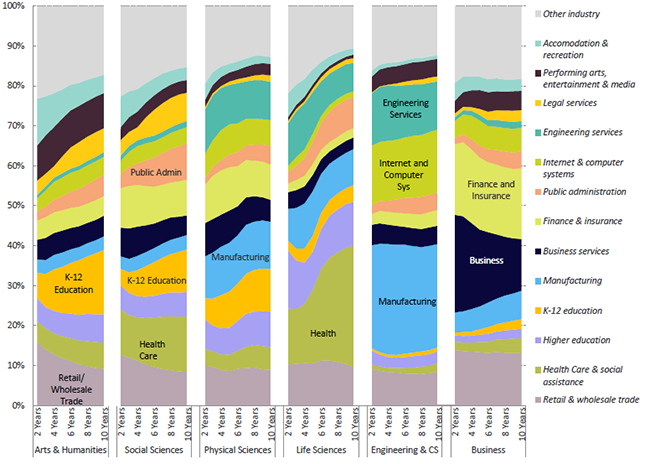
Source: California Employment Development Department and UC Corporate Student System.
Bachelor’s degree graduates often begin in positions within the retail and wholesale trade sectors but move on to high-skill industries such as education, health care, engineering and manufacturing.
A significant number of UC graduates go on to become educators within California’s K–12 and higher education systems. About 4 percent of UC graduates work in the state’s K–12 education system directly after graduation; about 9 percent do so within ten years of receiving their UC degree.
UC graduates also populate the state’s health care and social assistance workforce in large numbers. At ten years after graduation, about 12 percent work in health care or social assistance (30 percent among life sciences majors).
Large numbers of graduates of UC’s undergraduate STEM programs enter the state’s engineering and high-tech workforce. More than 15 percent of UC engineering/computer science graduates employed in California work in the Internet and computer systems industry, while another 12 percent work in the engineering services industry. The manufacturing sector has been a consistent source of employment for large numbers of UC engineering and physical science graduates.













